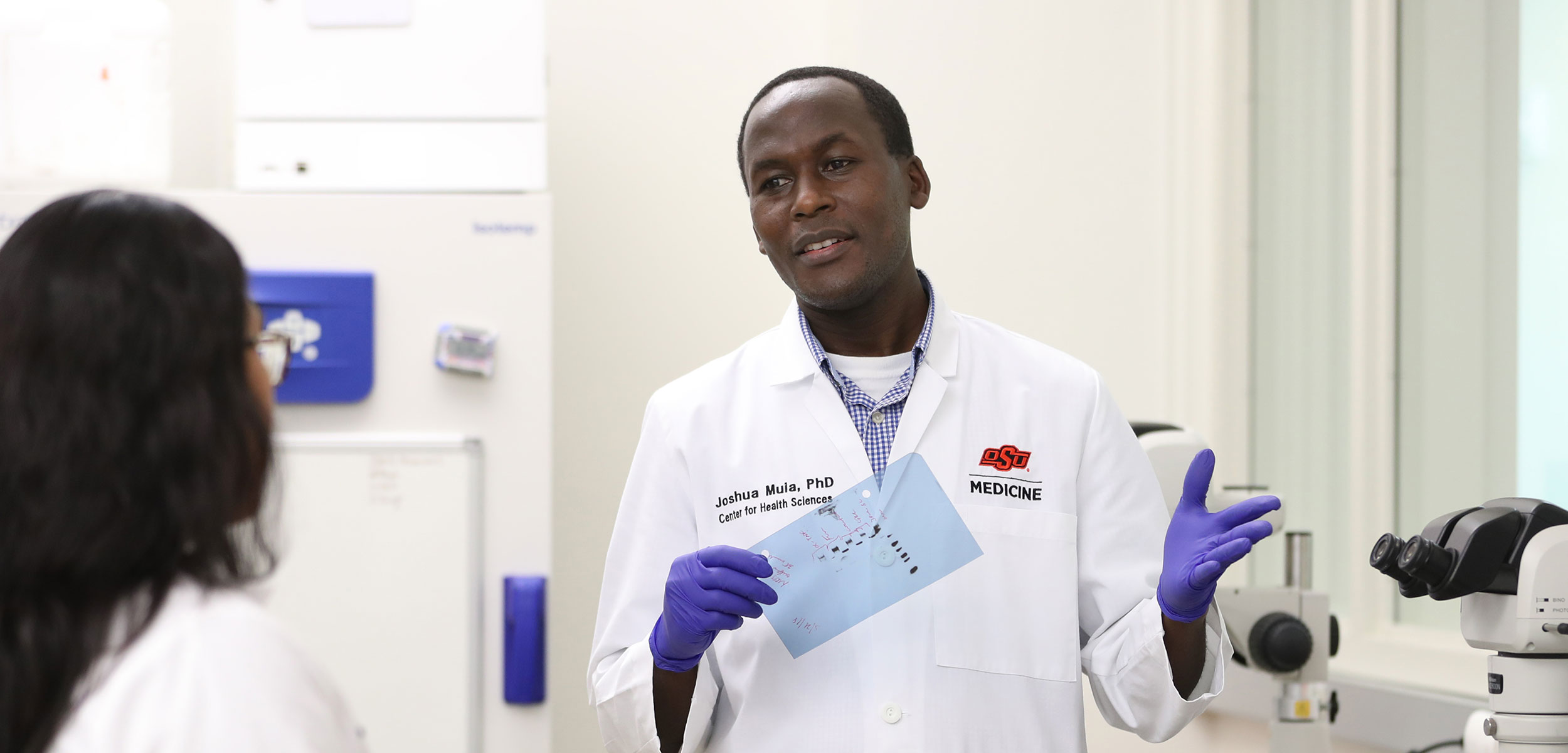
Biomedical Sciences faculty member awarded $1.67M research grant
Tuesday, December 21, 2021
Media Contact: Sara Plummer | Communications Coordinator | 918-561-1282 | sara.plummer@okstate.edu
Assistant Professor of Biochemistry Joshua Muia, Ph.D., is hoping his research into two tiny enzymes can help identify and possibly treat a rare blood disease as well as the most common form of heart disease.
Dr. Muia joined the faculty at OSU Center for Health Sciences’ School of Biomedical Sciences in 2020, and not only did he start a new job at a new institution in the middle of a pandemic, but he also applied for a national research grant, not an easy feat.
Muia was recently awarded a five-year $1.67 million grant from the National Institute of General Medical Sciences, part of the National Institutes of Health.
“Applying for a grant takes a long time and a lot of work,” he said. “Getting a grant isn’t easy, especially an NIH grant.”
Muia’s research is focused on two enzymes in the ADAMTS (A Disintegrin and Metalloprotease with ThromboSpondin motifs) family — ADAMTS13 and ADAMTS7.
The ADAMTS13 enzyme works to regulate how blood cells called platelets attach to blood vessels and control blood clotting.
“It’s a delicate balance of bleeding and clotting. We need clotting to stop a bleed, but we don’t want to form blood clots,” he said.
Whether through genetic mutations or an autoimmune response, a person’s ADAMTS13 can become dysfunctional and can cause serious health issues including the rare blood disease thrombotic thrombocytopenic purpura, or TTP, where blood clots form in small arteries in the body.
About two-thirds of people diagnosed with TTP are women and it can be associated with pregnancy. Diagnosing TTP routinely involves testing for ADAMTS13 activity levels in plasma, although no ADAMTS13 activity test is currently FDA approved.
Muia has already developed an ADAMTS13 test, or assay, that is compatible with not just human plasma, but plasma from any species.
“You can research similarities and differences between humans and other species in terms of the ADAMTS13 protein,” he said. “For example, right now, there’s no known natural inhibitors of the ADAMTS13 enzyme, which can be exploited as therapies for bleeding disorders caused by too much ADAMTS13 activity. By looking at other species we see the differences and we can understand how the enzyme is regulated and if there are other avenues to inhibitors.”
Before coming to OSU-CHS, Muia worked on a research team with the late J. Evan Sadler at Washington Univeristy School of Medicine in St. Louis, where they discovered how the ADAMTS13 is self-regulated as well as developed a novel ADAMTS13 test, which was used to screen patients for a TTP clinical trial.
The grant from NIGMS will allow for further research into ADAMTS13 across species as well as tests that the FDA could hopefully approve in the future.
The other ADAMTS enzyme Muia will research with the grant funds is ADAMTS7, a lesser-researched enzyme in that family.
There’s seems to be a strong link between ADAMTS7 and coronary artery disease, or CAD, the most common type of heart disease, he said, but there’s a lot that’s unknown about the enzyme, including its substrates.
Enzymes and substrates work together to create products like sugars, water, oxygen and carbon dioxide.
“If we know the substrate, we can come up with an assay, or test, for ADAMTS7,” he said, but without more information, physicians and scientists can’t make the connection of how ADAMTS7 may affect coronary artery disease. “If you want to build a house, you need the right tools. Without a tool, we can’t do it.”
This kind of in-depth and detailed work takes time and money, Muia said, so being awarded the grant is vital to his research.
Muia said applying for the grant as soon as he came to OSU-CHS could not have been possible without the unwavering support from the Associate Dean of Biomedical Sciences Bruce Benjamin as well as junior faculty mentorship through the NIH-funded Future Faculty of Cardiovascular Sciences (FOCUS) at the University of California San Diego.
He is also interested in training a diverse biomedical workforce and the grant will provide training and mentoring opportunities for students from high school through graduate-level programs who would like to gain research experience and aquire skills necessary for the next stage in their career.
“The grant means turning the ideas we have into a reality. What we discover can eventually help patients,” he said. “That’s the ultimate goal — how can our work help patients in the future.”
